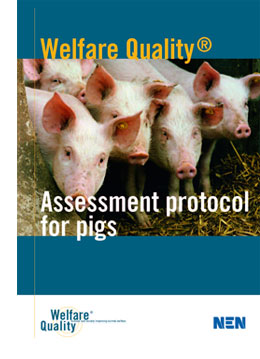 Assessment systems to evaluate the quality of animal welfare on farms or at slaughter, have been developed by researchers of the European research project Welfare Quality®. These systems for 7 livestock species are founded upon animal-based measures. The systems combine a science-based methodology for assessing farm animal welfare with a standardised way of integrating this information to assign farms and slaughterhouses to one of four categories (from poor to excellent animal welfare).
Assessment systems to evaluate the quality of animal welfare on farms or at slaughter, have been developed by researchers of the European research project Welfare Quality®. These systems for 7 livestock species are founded upon animal-based measures. The systems combine a science-based methodology for assessing farm animal welfare with a standardised way of integrating this information to assign farms and slaughterhouses to one of four categories (from poor to excellent animal welfare). The developed protocols can be used not only to assess the animals’ welfare but also to provide feedback and support to producers, thereby helping them to benefit from entry to some higher value markets. Furthermore, they will yield clear and reliable information for retailers and consumers on the welfare status of animals from which their food products were derived.
The animal welfare assessment systems are published as three separate books (for pigs, poultry respectively cattle) presented on 9 October 2009 at the animal welfare conference in Uppsala, Sweden.
Assessment Systems for Seven Livestock Species
After discussions with consumers and scientists, stakeholders, and policy makers, Welfare Quality® defined four animal welfare principles: Good housing, good feeding, good health and appropriate behaviour. Within these principles 12 animal welfare criteria were identified. The practical assessment systems measure each of these 12 criteria in seven livestock species: dairy cattle, beef cattle, veal calves, sows, fattening pigs, laying hens and broilers. The systems have been tested on more than 700 farms across nine European countries, from the UK to the Czech Republic, from Sweden to Spain, and even on farms in Latin America.
Animal-based Measures
 Researchers recognised that the best assessments came from observing the animals themselves. For each livestock species, around 40 different animal-based measures were identified in order to verify compliance with the 12 different criteria for farms or slaughterhouses. Based on scientific literature or research projects carried out, these measures were tested to make sure they accurately reflected the actual welfare of the animal.
Researchers recognised that the best assessments came from observing the animals themselves. For each livestock species, around 40 different animal-based measures were identified in order to verify compliance with the 12 different criteria for farms or slaughterhouses. Based on scientific literature or research projects carried out, these measures were tested to make sure they accurately reflected the actual welfare of the animal. Because animals are kept in so many different environments, it is important that the measures work across all systems. Since most of the measures developed by Welfare Quality® are animal-based, an assessor could verify the level of animal welfare by looking at the animal itself irrespective of how and where it is kept.
Due to group sizes, time restraints and other factors, it isn’t always possible to use animal-based measures. In these instances, resource- or management-based ones are used instead.
The measures were evaluated on validity (does it measure what we think it does), repeatability (do different observers generate the same outcome), and feasibility (is it possible to use the measure given the constraints of a practical assessment system).
To complement these systems, Welfare Quality® has joined with an independent standardisation institute to create the first comprehensive European set of protocols for assessing farm animal welfare.
The assessment systems were published on October 9th, although they should continue to be updated in the light of new scientific evidence.
The books can be ordered at the project office of the project: info@welfarequality.net
http://www.welfarequality.net/everyone/43148/9/0/22



